 |
||
|
||
| ||
In the previous part we examined the devices, which are widely spread in the market but none of them could record CD-R discs at the rate more than 8x. Today we will pay attention to the drives with the higher rate, which have just appeared on sale. If you haven't read the previous part, we recommend you to do it, otherwise you might not understand the abbreviations (i.e. CD-ROM XA or P-CAV). Due to the circumstances we included Yamaha CRW8424E for testing instead of ASUSTeK storage device. SCSI vs. IDESoon you can read a review with drives with SCSI-interface described. That's why we have decided to touch upon the question "SCSI or IDE?" Quite often in FIDO echoes or Internet forums you can come across the question "Is it true that SCSI has an advantage over IDE?" and "Is it worth to pay for the controller and SCSI pipelines/cords?" SCSI-interface is characterized by lower processor usage as compared with IDE, wide bandwidth, DMA (Direct Memory Access) support and higher data rate than IDE has. But it costs! IDE has one major merit: with acceptable rate this interface costs much less than SCSI. Besides, you don't need to buy IDE-cotroller as it's already installed in the motherboard (in modern computers); and recorders with SCSI and IDE drivers cost equal. When the data transfer protocols Ultra DMA/33 (UDMA2/ATA33), then Ultra DMA/66 (UDMA4/ATA66) and now ATA100 had appeared, IDE interface became more attractive for buyers. DMA mode relieved the processor (as compared with PIO (Processor Input/Output), it increased the performance of IDE. Some say that while IDE recorder working you'd better not even breathe, and while using SCSI drive you can even run Quake III. We decided to check it. Our testing program was Quake II as it loads both the processor and videosubsystem much. We have chosen the model PX-W8432Ti out of IDE drivers, and PX-W124Tsi as an "opponent". We used the standard demo - Timedemo1 map demo1.dm2 at resolution 1024x768. The testing machine was the same as in the previous review. And the discs we used were Philips Professional. First, we set the rate 4x and loaded Quake II. None even the huge battles could empty IDE buffer. It just slowed a little. The process of recording wasn't effected by it. As for SCSI, it worked irreproachably. On setting the rate at 8x, the recording (IDE) stopped while loading the game. When using SCSI drive, the game became slower, but the disc wasn't corrupted. The graph of recording was similar to that at the rate 4x. So, if you haven't got SCSI-controller, but you have powerful computer with large RAM and fast hard drive, then, IDE drive is enough. It will suit you as well, when you can wait with the completing of huge tasks while recording. Otherwise, you had better to use SCSI. However, it depends on the applications you are working with. What I did simultaneously was recording on the old Hewlett Packard 7570i at the rate 2x, scanning materials (the scanner - AGFA 1236s), receiving FIDO-mail, running WinAmp. For conditions and technology of testing, please, refer to the previous part. Testing samplesHewlett Packard CD-Writer Plus 9310i Testing technologyAs we said, the technology, as well as conditions, remains the same as in the part I. Please, notice, that the following results mustn't be considered as only that can proceed. Testing resultsCDWinBench 99 CD-ROM Transfer Rate 40x-rate CD-ROM is beyond competition with all the testing drives. Samsung SW-208B with 32x rate stands very close to it. The third one is Panasonic-drive. The other drives are approximately on the one level and show the standard rate for the devices of their class. As for low results of Yamaha, do not forget that it is only one of 24x rate devices here and its results are normal for this class.  The results are quite interesting - all drives, but for Yamaha CRW8424E, won over CD-ROM Teac CD-540E. Ricoh MP7080A is a bit ahead, though in general the results are similar. Yamaha for its class "looks" well. The CPU utilization was:  When implementing CD-ROM Transfer Rate tests Teac CD-ROM utilized CPU most of all. Hewlett Packard 9310i together with the Yamaha recorder did it least. Ricoh MP7080A shows the best results of CPU utilization (notice, it was the leader in Outside Transfer Rate test). Taking into account good results in CDWinBench 99 CD-ROM Transfer Rate tests, Samsung SW-208B and Panasonic CW-7585 drives deserve high mark for CPU utilization. Besides, in this test and in CD-ROM Access Time test Sony and Hewlett Packard show different results. And again, in the given test, Hewlett Packard drive shows the best. CDWinBench 99 CD-ROM Access Time All drives correspond to the stated access speeds. Samsung became a leader among the recorders. As for its claimed access speed, it's the least as well. We shall notice, that Sony CRX145E-RP gave 98.2 ms instead of the claimed 125 ms. CDWinBench 99 CPU Utilization This test determines the whole system utilization with the drive working in it. Samsung SW-208B and Panasonic CW-7585 gave the best results, Yamaha was the last one. Sony and HP results were similar. Ricoh drive showed average results. Recording timeRecording of the normal quality disc 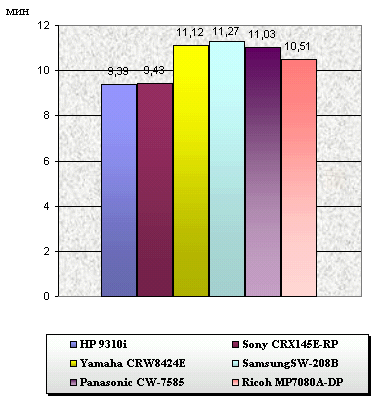 Hp and Sony have got similar results, but remember, they record at 10x rate. Among 8x rate recorders Ricoh bore the palm. Panasonic was close to it. Being the first as a reading drive, Samsung SW-208B was the last as a recording one. Recording of the low quality disc (4x). 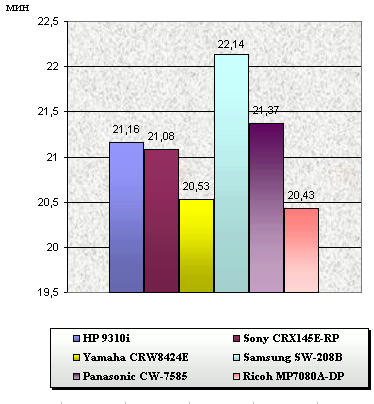 Ricoh shows the highest speed. Yamaha follows it. But Samsung failed, unfortunately. CD-RW (UDF) record  Ricoh wins the Cup in CD-RW recording again. HP 9310i and Sony CRX145E-RP follow with the difference in 9 seconds. This attempt of Samsung failed again. Formatting time of CD-RW in UDF format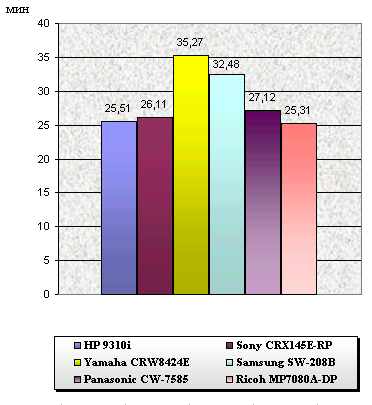 And again Ricoh doesn't allow to outrun him. HP and Sony don't leave the leader. Yamaha passes PacketCD with 4-second difference. Please, notice, that "HP Fast Format" of Hewlett Packard, which allows to record the data on the disc in 6 minutes, wasn't used in this test. Graphs of reading of recorded CD (normal quality). CDTest99
Graphs of reading of recorded CD (low quality). CDTest99
The green line is a reading speed (left scale), the yellow one is a disc rotation speed, rpm (right scale). CD-ROM Teac CD-540E showed very close graphs for all drives, that is to benefit of this device. You can study the graphs of reading in the previous part. I represented 2 graphs of reading for Sony drive, because neither in DMA nor in PIO Mode I couldn't wait till the subtest finished. That's why I had to run these subtests separately to achieve the results . CD Speed 99 testing results of the recorded CDs (normal quality)
CD Speed 99 testing results of the recorded CDs (low quality)
*n/a - no figures as the test wasn't completed
Like in the last testing, all graphs of normal discs are straight, but for that of the Yamaha storage device. As for low-quality CDs, Panasonic and Samsung have got straight graphs. Ricoh and Hewlett Packard graphs were worse to the end. However, 9310i of Hewlett Packard performs better than 8x model. Panasonic CW-7585 shows 8x initial and 16x terminal speed. CD Quality Check testing results of the recorded CD-RW (UDF)
CD Quality Check testing results of the recorded CD-RW (ISO)Sony, Hewlett Packard and Ricoh were the best when working with CD-RW. Yamaha-drive performed the best in ISO format but was the last in UDF. Quality of the recorded CDs of normal quality (CD Quality Check)
Quality of the recorded CDs of low quality (CD Quality Check)
*n/a - the measuring failed.
Take a look at Ricoh MO7080A-DP: it performs better on low quality CD than on high quality one. Sony and Hewlett Packard have similar results. Quality of the recorded CDs of normal quality (CD-ROM Drive Analyzer)
Quality of the recorded CDs of low quality (CD-ROM Drive Analyzer)
Hewlett Packard 9310i achieved the most stable graphs, and it not surprising because the CDs were read at 6x rate. Sony showed the lowest result. Samsung showed the highest speed and no falls. Yamaha recorder has similar graphs both of CDs of normal and low quality, but they are too uneven. Ricoh failed when reading the CD of low quality: in the end the amplitude was oscillating. CD-ROM TEAC CD-540E showed quite stable graphs if not counting decreasing of the speed to the end, practically in all cases. Extraction of Audio tracks from Audio CDs (CDDAE 99)Piano Favorites
Acoustic Planet vol.2
Bloodhound Gang "Greatest Hits"
* - 3.04% means that the drive extracted 3.04%
of the CD with errors
Samsung at the rate 12x extracted tracks and on every CD made some percent of errors. Yamaha and Ricoh showed high results ( high speed together with minor of errors). Panasonic is close to them; it has made quite a number of errors when extracting tracks from CD Piano Favorites. Sony despite the low speed has made minor errors. Next to it stands Hewlett Packard 9310i which has more errors. Copying from recorded CDs onto the hard driveSince the disc structure is nonuniform and compound, the results were low even for 32x devices. Copying of normal quality CD 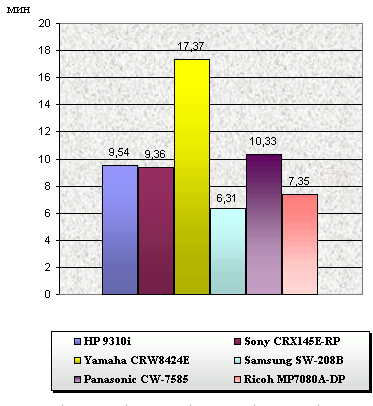 As for data reading, Samsung drive is the first. Ricoh is behind with 1 minute difference. Panasonic CW-7585 appeared the last but one. And the last one was Yamaha. Copying of low quality CD 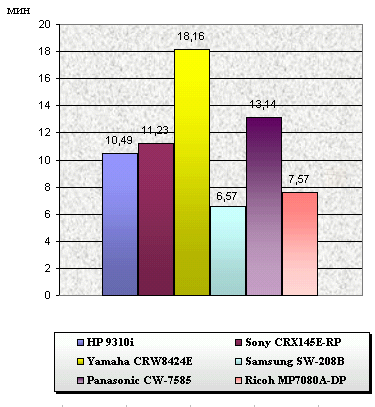 Samsung is a leader again and Yamaha is in the end. Reading of damaged CDYamaha CRW8424E : "Golden" CD:  Scratched:  Both golden and scratched CDs were read hard. You can see it on the graphs. In the end the hard drive decreased the speed to 4x, and further the max. speed was 6x. Only 35% of the damaged disc were read. At the speed 2x it constituted 45%. Samsung SW-208B : "Golden" CD: 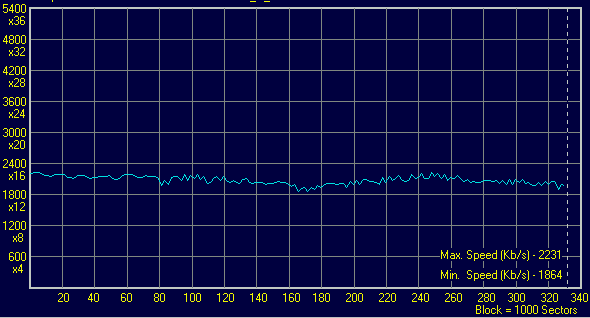 Scratched: 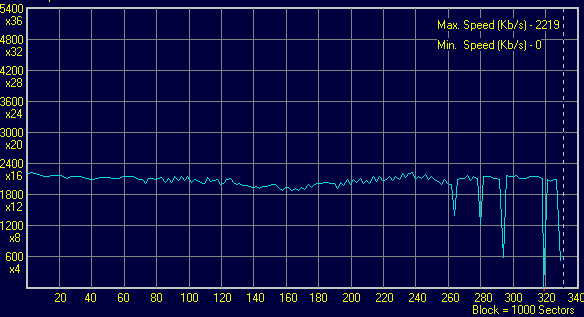 The golden disc was read perfectly. As for the scratched disc, you can see the falls on the graph, in one place the reading speed was equal to 0. 75% of the scratched disc were read. Panasonic CW-7585 : "Golden" CD: 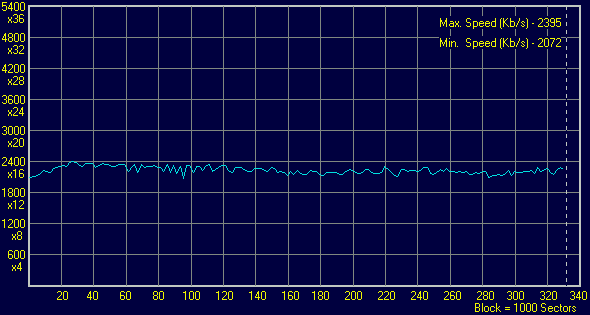 Sctatched: 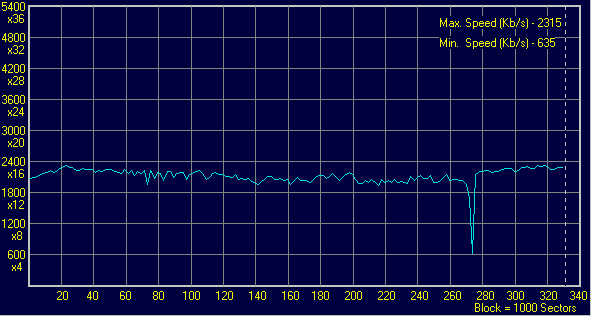 The results of the damaged disc reading are the best. When reading it, the speed decreased first, but then it took the initial value again. So, scratched CD reading constiteted 78%. Ricoh MP7080A-DP : "Golden" disc: 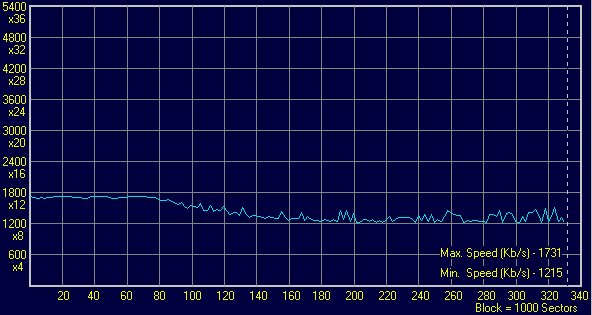 Scratched: 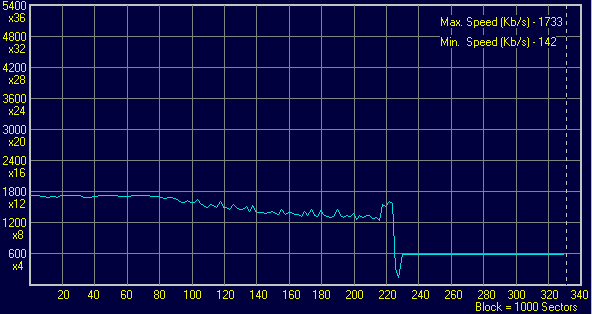 When reading the golden disc, the speed decreased to 8x. As for the scratced disc, the speed first fell to 2x, then rose to 4x and remained 4x up to the end. 60% of scratched disc were read. Sony CRX145E-RP : "Golden" disc: 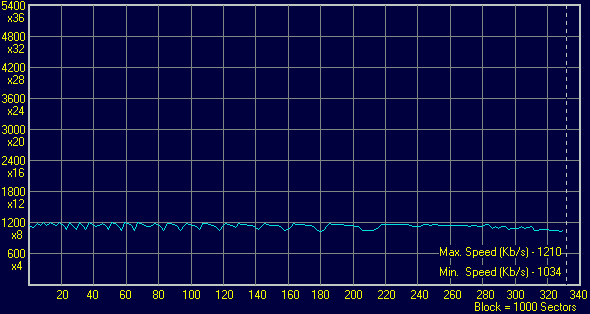 Scratched: 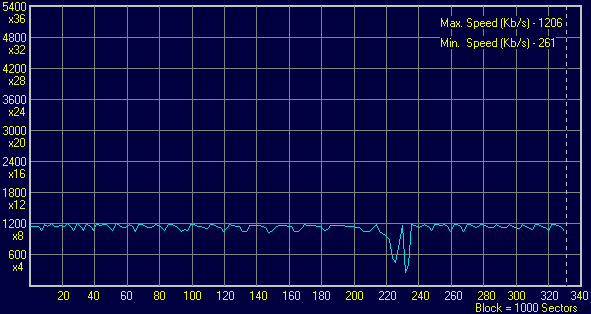 Reading of the golden CD is quite good, though the speed might be higher. After the drive passed hard section of the scratched CD, it raised the speed up to 8x. 60% of the damaged disc were read. Hewlett Packard CD-Writer Plus 9310i : "Golden" disc: 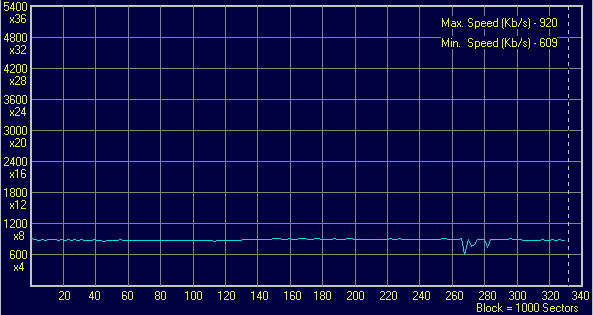 Scratched:  The graph is quite straight, but the speed is only 8x of 32x-speed device. The low speed explaines smooth passing of the hard section on the damaged disc. 65% of the damaged CD were read. ResumeJust like in the previous review, all drives recorded the data on 700 MBytes CDs easily. Some manuals of drives mark this possibility separately. Yamaha CRW8424EHigh speed of track extraction. Processing of CD-ROM discs is on the 24x device level. Fast record of CD-R at 4x, and acceptable one at 8x. The large buffer works stable and got empty easily when large applications are run simultaneously. During the testing it didn't damage any CDs. Moderate processing of CD-RW. The drive couldn't read the disc formatted in Hewlett Packard 7570i. The technical support is excellent: the site gets renewed quite often, new versions of firmware upgrade are appearing. Samsung SW-208BIt's a leader in reading discs. Though it is not enough for CD-RW drive. The recording is low. On the 21 minute of formatting it stopped recording CD-RW saying that the disc is damaged. One more disc was formatted easely. While the testing it damaged one Philips Professional CD. During the recording the buffer got emptied at once, and the recorder dropped out the disc. However, usually the buffer makes no troubles. Panasonic CW-7585Usually it was in the middle of the table. Both CD-RW and damaged CD are operated good enough. The buffer didn't perform well: at 8x it was completed for about 85-95% if there were no other applications. Otherwise, it constituted 35-45% (i.e. Photoshop is run). One CD got damaged in the beginning of recording. Though this CD might be defective itself, because no more discs (Philips Professional and 700 MBytes TDK) were damaged. Ricoh MP7080A-DPIn all tests it showed high recording speed both of CD-R and CD-RW. CD-RW processing is fine. And it hasn't damaged any discs. Sony CRX145E-RPThis drive is analog of its 8x model but for the recording speed of CD-R. Like Sony CRX140E-BP, it didn't succeed in recording. The graph of reading of technological disc is quite uneven. Track extraction is good enough. Working with CD-RW is excellent. Fast read, high quality record at 10x gives advantage (together with HP 9310i) as compared with othe 8x devices. The buffer didn't cause any problems at 8x, even when parallel applications are run. But it wasn't so smooth at 10x. F.e., Windows Commander booting emptied the buffer to 50% at 10x. Hewlett Packard CD-Writer Plus 9310iAs we said, Hewlett Packard 9310i is very similar to Sony CRX145E-RP. Like Hewlett Packard 9110i which has no problems peculiar to Sony CRX140E-BP, Hewlett Packard 9310i has no difficulties in track extracting and recording on CDs. ConclusionYamaha CRW8424ELow price, CD-R recording at 8x and wide availability made it popular. The drive extracts the tracks quite well, doesn't utilize CPU too much, works silent - these are its marits. However, there are many similar drives appeared, so, you are to think to choose the best one. Samsung SW-208BThe recorder showed excellent reading speed and access speed. It operates with damaged CDs quite well. But it is inrefior to all tested drives in recording of CD-R and CD-RW. Taking into account the price, I'd better pay attention to Ricoh or Panasonic. Panasonic CW-7585Moderate performance in recording and reading. It operates with damaged CDs, records on technological discs and read CD-RW at high speed quite well. When reading it makes noise. Taking into account low price and good performance it might be one of the alternatives. Ricoh MP7080A-DPIt's one of the best drives here. It's the second in reading data after Samsung SW-208B. One of the weak points of it is reading of damaged discs. High recording speed, little utilization of CPU, high access speed and silent work give it priority. Sony CRX145E-RPThis recorder (together with CRX140E-BP) is the best choice when you need to record very often, esspecially quite a number of discs, with no extra time and when 8x is not enough. It's a good competitor of IDE drive of Plextor. But in this case it's better to use technological CDs seldom. The recorder is silent, no vibration. Speed and quality of reading are high. Reading of CD-RW is the best here. Hewlett Packard CD-Writer Plus 9310iAs we mentioned, it's similar to Sony CRX145E-RP. Maybe, only design is a little bit better. Unlike Hewlett Packard 9110i and CRX140E-BP drives which deffer in price, Hewlett Packard 9310i and CRX145E-RP cost equal. So, it would be difficult to choose one of them. In the next part:
Programs used for testing:
Write a comment below. No registration needed!
|
Platform · Video · Multimedia · Mobile · Other || About us & Privacy policy · Twitter · Facebook Copyright © Byrds Research & Publishing, Ltd., 1997–2011. All rights reserved. |